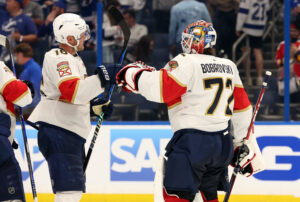The Toronto Maple Leafs fourth line may not get the fanfare of other lines. The entire group won’t get the fanfare all year that John Tavares has had already. The Maple Leafs fourth line probably isn’t even going to see much ice time this season. But it’s going to be one of the more interesting topics this season in Leaf Nation. If only because who exactly is going to play on the line may change from week to week.
The Toronto Maple Leafs Fourth Line Expectations
The traditional checking, and sometimes fighting, fourth line is slowly dying in the NHL. The New York Islanders aside, who seem to be going with two checking style fourth lines next season. The Maple Leafs traded Matt Martin and let Leo Komarov walk in free agency (both went to the Islanders). The departure of those two players indicates the Maple Leafs are going a different direction this season. They want four lines that are quick and can score.
Who’s Not On The Fourth Line
One interesting debate we’ll see this season is which line is Toronto’s top line. The top two lines may exchange players from time to time. But aside from Zach Hyman moving down to the bottom six to get one of Andreas Johnsson or Kasperi Kapanen more ice time, the top six is set.
In no particular order, the top two lines will consist of Auston Matthews, Mitch Marner, William Nylander, Patrick Marleau, Hyman, and Tavares. Which of the Matthews line and the Tavares line is the top line may be in question all season, but which players make up those two lines will not be.
The Third Line
The third line is marketed as a shutdown line, centred by Nazem Kadri. But it’s really another scoring line. It’s not going to be comprised of a wealth of defensive forwards. Kadri has done a good job as a shutdown center in the past, finishing 20th in Selke voting in 2017. But he had a 49.1 percent in Corsi-For and -1.6 percent in relative Corsi last year. Those are not stellar defensive numbers. He’s also coming off back-to-back 32 goal seasons. Another reason to think he’s better off on an offensive line than a checking line.
We’ll have a much clearer picture in a month, but there is a more than good chance one of (or both) Johnsson or Kapanen will be on the third line with Kadri. The other option for Kadri’s wing is Connor Brown.
It’s not to say that any of these players can’t potentially play well defensively. But a line that’s made up of three of Kadri, Johnsson, Kapanen and Brown is a scoring line. And like the top two lines, it will be a line that can play fast and potentially put in a lot of goals.
Who Will Be On The Fourth Line
Which Of Brown And Kapanen Will Play The Right Side?
One of Johnsson, Kapanen, and Brown will be a regular on the fourth line. Since Johnsson plays the right side and Kapanen and Brown play the left, it will probably not be Johnsson.
Brown has more experience. But the allure of two speedy wingers playing with Kadri is strong. Brown scored 20 goals in his rookie season, but he dropped to 14 and 28 points last season. He’s going to be looking to regain his rookie success.
It’s not a guarantee that either Johnsson or Kapanen will become regular offensive contributors in the NHL. But they have both shown offensive ability in other leagues. This year will give Kyle Dubas and Mike Babcock a chance to get a good idea of what these players may be in the NHL. But not if they’re mired on the fourth line.
Both Kapanen and Brown will likely see time on both the third and fourth lines.
Who Will Center The Fourth Line?
Who plays center is the biggest fourth line question. The early favourite is Par Lindholm. Lindholm finished fourth in scoring in the SHL last season. He may not be able to reproduce that offensive in the NHL. But he’s not being brought in to play a traditional physical fourth-line forward role. Lindholm was signed as a potential center for a scoring fourth line.
Other options at center include Tyler Ennis, Josh Jooris, and Frederik Gauthier. None of those players are significant physical threats. Although Gauthier was drafted as a defensive forward, he is also a long shot to make the team. He’s not quick enough on his skates to keep up with the team’s speedy style of play.
There’s also still the possibility Dubas will bring in another player to fill the fourth line center role. At this point, however, it’s most likely the team will evaluate what they have. If no one proves capable of filling the fourth line center role effectively, Dubas will look for a mid-season or trade deadline acquisition.
And the Left Side
Ennis is the front-runner for fourth-line left wing heading into training camp. Unless he winds up taking the center position for that line. But that’s not very likely.
There’s also Josh Leivo. What the Maple Leafs do with him this season is another very interesting question. Leivo should either play consistently this season or be traded. Many will have him as the front-runner for the fourth line left wing. But Babcock’s reluctance to play him puts him as a long shot for now.
Every Game Is A Tryout
‘Every Game Is A Tryout’ was a Toronto Marlies slogan during the Brian Burke years. It fits well for the fourth line this year. With three (and a bit) lines worth of forwards already set, there’s really only two open spots in the Maple Leafs forward group.
The Maple Leafs will use those spots in two ways. The first is by helping ice a team that can win hockey games. Ennis and Jooris were signed to bring some stability. You know what you’re getting with them for the most part. But in the Dubas/Babcock era, veterans are not guaranteed spots. The best players will play. The second use of those spots is giving players, both veterans and rookies alike, the chance to prove that they can help the team win. That means giving different players opportunities.
How Will The Fourth Line Play
Some say that top six forwards shouldn’t be promoted to the NHL until there is a spot in the top six. Or as part of the third line with an offensive mindset perhaps. The thinking is that skilled players should not be brought up to the NHL to play a checking role. It’s not their game. But if the Maple Leafs are moving away from the traditional physical fourth line, it’s to put young skilled players in that role. Players that could be given an opportunity include AHLers Carl Grundstrom, Mason Marchment, Adam Brooks, Pierre Engvall, and others from the Toronto Marlies.
If the Maple Leafs use the fourth line as a gateway position to the NHL for young players, it will provide them with a couple advantages. They’ll get an opportunity to see young players play their own game in a sheltered role. Offensive players will be expected to be offensive and not have to suddenly learn a checking style of game.
The other advantage is the Maple Leafs can play a consistent game across all four lines. Opposing teams will have to address four lines that are quick and looking to score goals. They’ll frequently be able to find at least one line that can take advantage of a bad matchup. That’s going to lead to many goals.
What About Defense?
The other side of this coin is that the Maple Leafs may struggle on defence, but it’s clear that the team’s defensive success will depend on puck possession. The Leafs will prevent goals by having possession of the puck most of the time. The best defence is a good offence. What Dubas is bringing into question is if a good defensive team needs a hard-hitting line. Or even a check first type of player at all.
This style doesn’t guarantee success, but the league is moving towards a game that rewards speed and creativity above physical domination. The Maple Leafs are embracing that trend.
Conn Smythe said ‘if you can’t beat ’em in the alley, you can’t beat ’em on the ice’. That was true for a long time. But the days of Scott Stevens laying waste in the neutral zone are over. You don’t need a pile of goons to have good team defence anymore.
Ice Time
One thing for certain is the fourth line is not going to see a significant amount of ice time. Not with Tavares, Matthews, and Kadri centring the first three lines. That means whoever’s playing on the fourth line is going to have to shine when they can.
The fourth line has been called the ‘Energy Line’. The idea behind that term is the fourth line comes out and bangs up the other team to provide a spark of motivation for the more skilled players. This year’s fourth line may also wind up as an ‘Energy Line’. But instead of trying to provide energy by showing how hard they can hit and punish the other team, the Maple Leafs fourth line will be quick, able to score and have a wealth of their own energy. Putting them on the ice rested and with a hunger to score against a tired opposition may end up being the talk of the NHL. As far as fourth lines go anyway.






